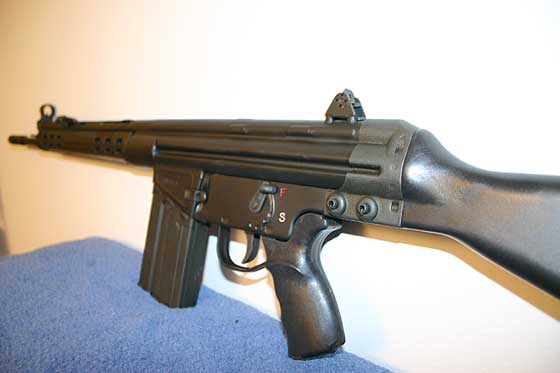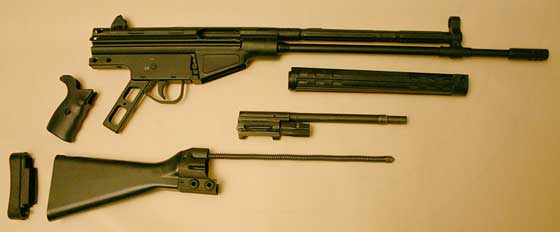|
Pre-Firing Assessment: These
rifles were originally built on the basis of German
WWII designs which culminated in the famous Heckler
& Koch G3 rifles (known in the civilian world as
HK-91s). The original G3 rifles were all select-fire,
meaning optional full-auto mode. Indeed, the current
Century Arms CETME has a position on the safety for
full-auto mode that has a stamped-steel stop to prevent
travel to that position. With a good bipod, and a heavier
barrel, they might have been decent select-fire weapons
for expedient duty as a light machine gun, but the overall
design is all wrong for that role. They are surprisingly
light weapons, and were built as an infantry battle
rifle. Without the ability to easily change the barrel,
they were almost never used as an automatic rifle in
combat.
Original H&K receivers were forged
aluminum alloy, and CETME rifles started off as cast
steel and evolved to stamped stainless steel receivers
to greatly cut production cost. Due to the closed-bolt
roller-block design, there is no need for a full receiver
forging. All of the pressure is contained inside the
chamber.
In 1999, a small
firm in Arizona began making clones of the German HK-91
using surplus German and Pakistani parts. Shortly after
that, a small company called Special Weapons was contracted
by Century Arms of Vermont to use their steel casting
techniques to produce parts and receivers to be mated
with surplus Spanish and various African military rifle
parts to produce new rifles. The first production rifles
were pretty rough (I saw them at gunshows and they looked
like steel versions of dog poop), but being less than
half the cost of a decent HK-91 clone and not even close
to the cost of a Genuine HK-91, they snagged a good
portion of the U.S. market share and had an early reputation
of being a "not half bad" clone. It was only
a matter of time before the HK-91 clones built with
parts from surplus German H&K G3 rifles would evolve
into Spanish CETME clones, built on the very similar
but cheaper CETME rifles. Interestingly, it was the
CETME that came first, and they really don't "cost"
any less to produce, just that the bulk of international
surplus stock was obtained at lower prices.
Spare magazines for the CETME are so
inexpensive that one can consider them disposable when
purchased in quantities of ten or more (I bought
a bunch for $3 each at www.cheaperthandirt.com).
Spare parts can be obtained by purchasing a de-mil parts
kit from any one of a number of suppliers for well under
$80. Note that many of the parts kits being sold online
contain full auto parts that I would not even recommend
TRYING to purchase if you had a CETME rifle. Even if
you wanted to risk the scrutiny, you would need to
do some modification to some parts for them to lawfully
be used in a semi-auto CETME. I wouldn't even want to
touch that issue, let alone own parts that the ATF could
consider Class 3 parts with a rifle. This rifle is useless
as a full-auto rifle anyways, so don't even dance that
dance.
Faced with respectable, but not extraordinary
sales, the people at Century Arms and probably Special
Weapons homed in on what was one of the bigger problems
with the re-engineered rifles. That being the cast stainless
steel receiver. Original specifications called for a
formed sheet metal receiver. A decent functional formed
sheet metal receiver came out in mid year of 2002 along
with a hefty price reduction in the rifles. Low cost
and cheap (really cheap) accessories make the .308 caliber
CETME a readily available choice for anyone who is looking
for a multipurpose utility rifle that will get banged
around on an ATV or behind the seat in a pickup truck.

Marketing Text
Right from Century Arms: All CETME rifles,
like the H&K G3, are a roller lock, delay blow back,
design with fluted chambers for reliable functioning
even in the worst conditions. These are built using
a precision cast, 17-4 stainless steel receiver. This
receiver is produced using the latest vacuum cast technology
by one of the leading aerospace casting firms in the
U.S.A. Each casting is hot straightened to ensure flawless
functioning and heat treated to 42-47 RC for superior
strength and wear resistance. The rifle is finished
with a baked on gray/black paint just like the H&K
process.
Original H&K G3 and Model 91 rifles
come with H&K designed 20-round steel magazines,
which were later modified to the same specs but made
out of aluminum. Spain made a different magazine for
their CETME version that has a different set of external
ramps for feeding and magazine engagement, and also
sports a visible forward banana-bend compared to the
straight 90-degree G3/HK91 mags.
Magazines: Century Arms provided
one original Spanish CETME 20-round steel magazine,
and one G3 20-round steel magazine. I bought a slew of H&K 20-round aluminum magazines. Not all of them will properly fit of feed, but they are cheap enough to just find out which ones are good and then just toss the ones that don't.
First words, loading magazines:
both G3 and CETME mags are decent enough to get the
first ten rounds into, and then they are a little difficult after that. Strong
fingers and lots of scar tissue near fingernails is
desired. They both have really strong magazine springs,
and if you mis-load a round, you really need to show
it who is boss. H&K G3 mag was more fun to work
with. Suprisingly, it fit together in the mag-well of
the CETME better than the CETME magazine, too.
Loading the 1st Round: The bolt
is engaged externally on the top left of the barrel.
Not the best place for either a "lefty" or
a "righty" actually. As a "righty,"
I held the pistol grip and reached out and racked the
bolt with my left hand. Nice and crisp retraction of
the bolt, and I could see that a round was stripped
from the magazine when I let the bolt go home.
First Firing: the first round
was let off with a classic 2-stage military trigger.
It took about 2 lbs. on the first stage to take up the slack,
and then a pretty crude 7-lb. trigger break on the second stage. About what I
expected, actually. The CETME/G3 trigger can be refined,
and I will send all the fire control pieces into the
garbage and buy a new set made of steel alloy parts
that can be honed to a better trigger break. That will
cost about $100.
Breaking In:
First Magazine (20 rds): After
one round that chambered, I had about a 1:5 ratio of
successful rounds fired to rounds that I had to eject
with their firing pins dented and I threw them off the
range.
Second Magazine: about 1 round
fired per 4 rounds attempted. The tolerances between
the receiver and the locking lugs was rather tight.
This was okay. I put some expedient synthetic grease
on the sides of the bolt behind the receiver rails.
Third Magazine: about 1 round
fired per 3 rounds atempted. The bolt is finding its
place in the receiver.
Fourth Magazine: bang, bang,
bang, bang, --stovepipe-- ejection failure.
Fifth Magazine: bang, bang, bang,
bang, bang, bang, bang, bang, bang, bang, bang, bang,
bang, bang, bang...etc...
Sixth Magazine: no more malfunctions,
the bolt has found the groove in the receiver and the
locking lugs.
Accuracy:
I shot this rifle from 50 yards out
to 100, 200, 300, 400 and 600 yards. The sights are
combat-adequate and are right on the money. Not all of the Century Arms rifles have sights that work out of the box. Apparently it is a crapshoot whether you get a good one or not.
Sights:
Rear sights are flip aperture sights
from Zero (no aperture) to 200 meters, 300 meters and
then 400 meters.
Front sight: an adjustable front post
with windage and elevation built in from the front.
No sight adjustments were needed for
sighting from 50 yards to 400 yards.
Overall:
This is a seriously nice knock-off of
a true $1500 HK91 rifle. Break it in properly first
before you ever plan on using one for serious work,
and make sure it feeds okay with the magazines you have.
Note that standard CETME mags as well as HK G3 mags
both need a solid "rap" to seat properly in
these rifles. Don't be shy about smacking the mag home.
Failure to seat a mag properly will result in a bolt
riding right over the next round and a "click"
on the trigger. Not a good thing if you need to be firing.
Sights are adequate for medium-range combat.
Don't even think of putting an optical sight on this
rifle. It wasn't intended to use one, and isn't designed
to accept one unless you monkey around with strange
aftermarket scope mounts. This is a true combat battle
rifle designed for medium range (200 to 600 yards) firepower
chambered with NATO FMJ ammunition that will defeat
light-to-medium cover materials and still kill an enemy
behind that cover. It is a highly accurate rifle by
combat standards, and will relatively shoot the same
ballistics whether the rifle is shot cold or hot. A
"sniper" rifle it is not, and adding an optical
sight just hinders this lightweight rifle and makes
it unusually heavy.
Bang For The Buck: Extremely
High. Buy one of them now, while they are still inexpensive.
I bought this on sale at Dunham's Sporting Goods for
$300 in early 2005. They are routinely selling for $500
and up as shooters realize the value in these Century
Arms models.
Photos: CETME
test firing

|